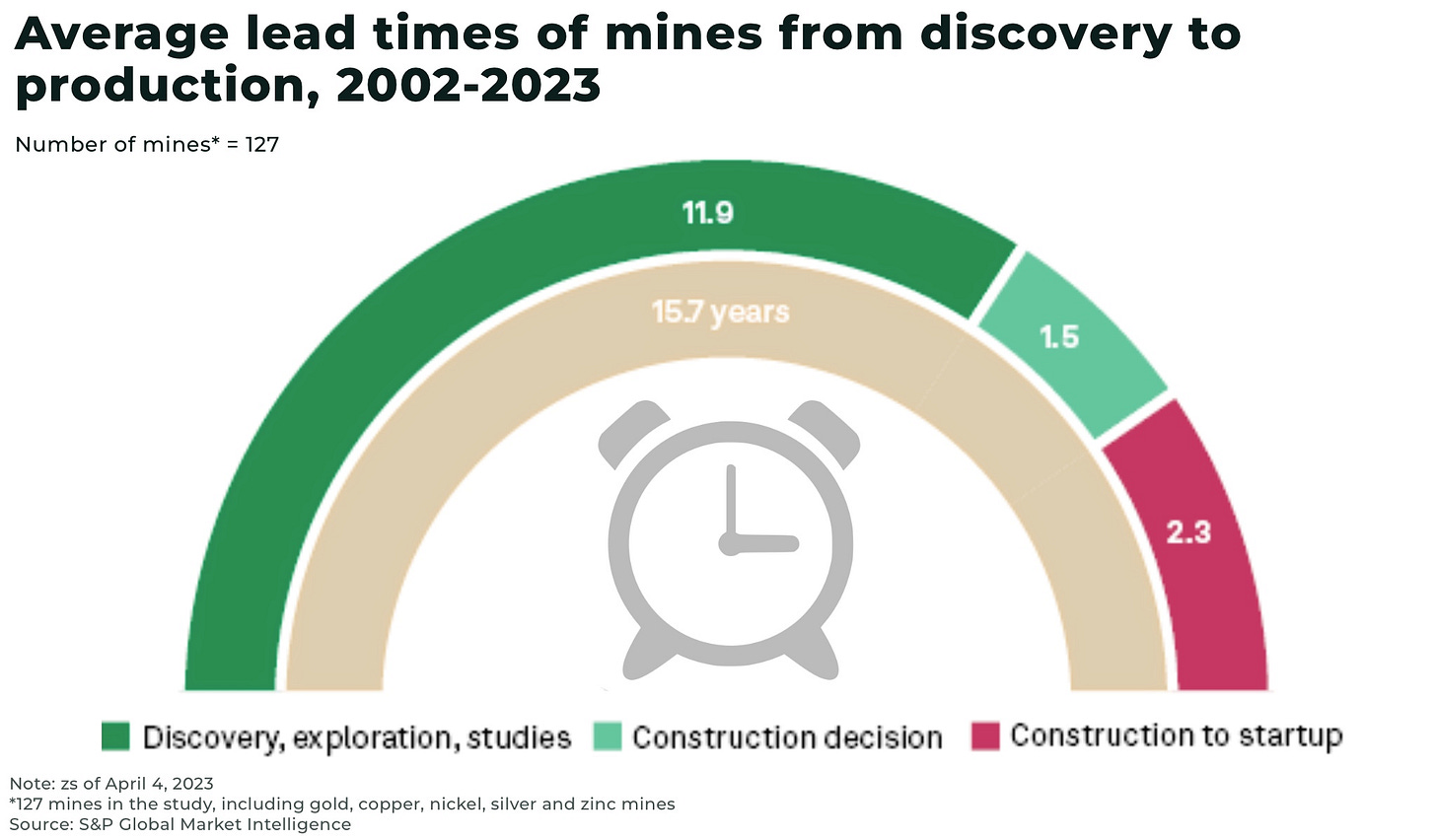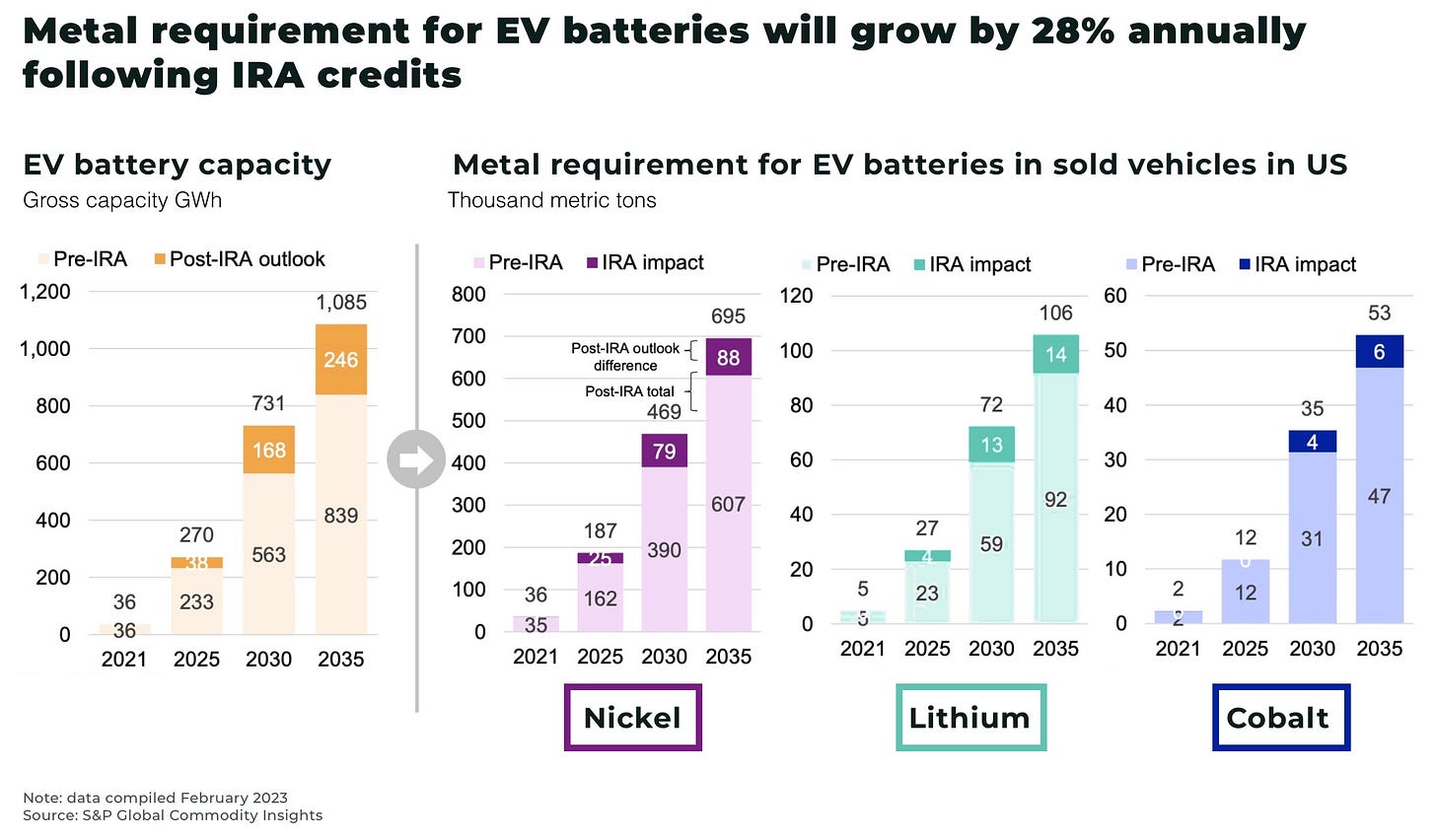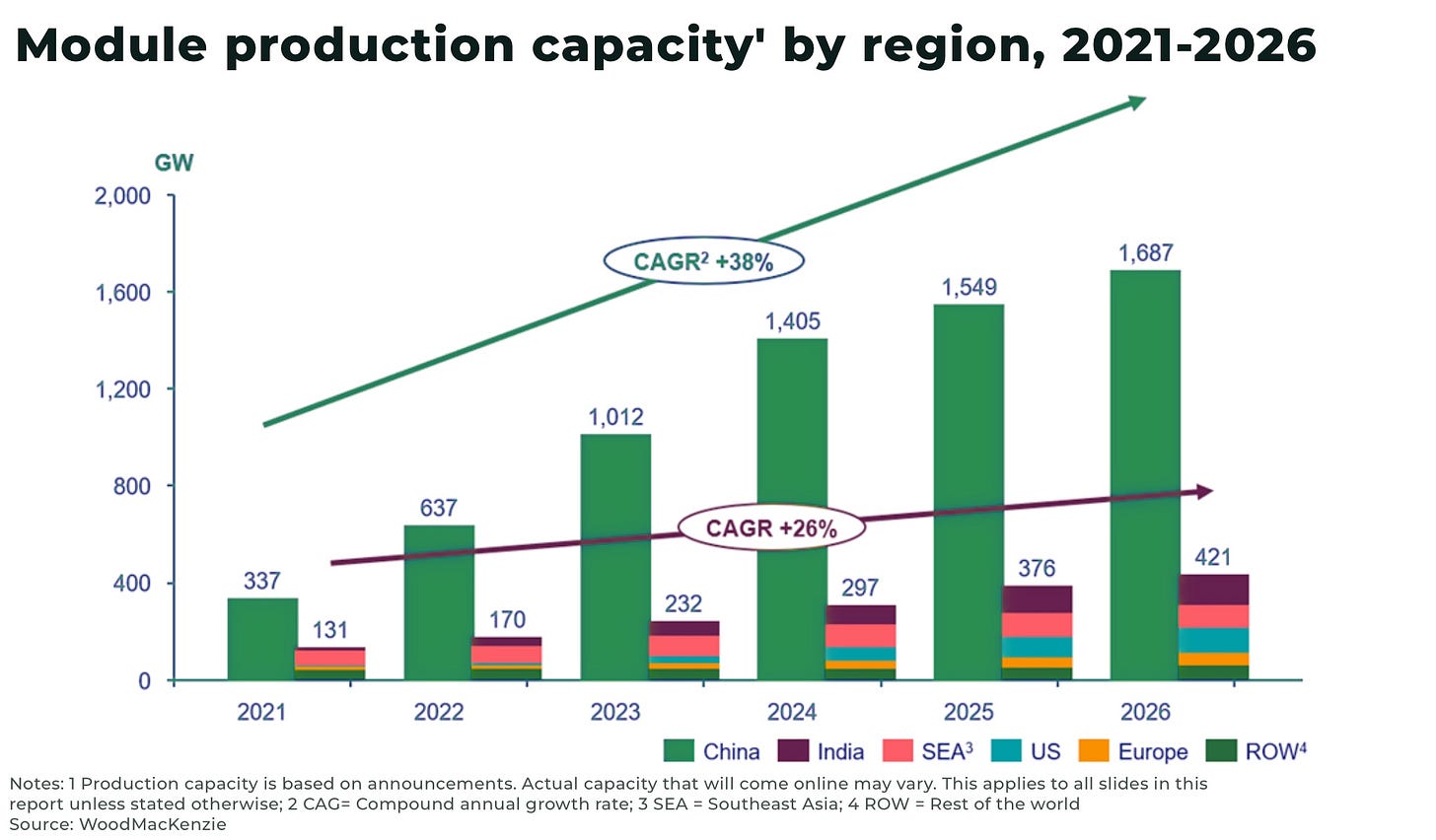Will the Inflation Reduction Act survive America's 2024 election?
There's a political weakness at foundation of US energy transition legislation
there is a political weakness at the foundation of the Inflation Reduction Act — it was passed only with Democrat party votes
Republicans signaled plans to “gut” the legislation if elected
but the mining industry, regardless of who wins, is set to benefit
🚀 Please smash the ♡ button, subscribe for the banter ✓ and share with friends and colleagues. We are always grateful for your comments and support.
Donald Trump is planning to “gut” the Inflation Reduction Act (IRA) if he’s re-elected to the US Presidency in 2024, calling it the “biggest tax hike in history”.
And Trump is not alone among Republicans.
For example, Ron DeSantis, governor of Florida running in the Republican primary, is one of four state governors who have rejected funds from the IRA, and, Nikki Haley, another Republican candidate, proposes repealing the IRA's tax credits.
The US presidential election, set for November 5 2024, may seem a long time off in comparison with daily stock market moves, but for anyone making decisions on long-term, billion-dollar mining or electric vehicle factory investments — the average time to develop a new mine can be more than 15 years — the next presidential election could be critical.
Firstly, to be clear, this is not a projection on who might win the election, but how investors should be prepared whoever wins.
So, what does the next US presidential election mean for the energy transition?
What is the Inflation Reduction Act
President Joe Biden’s signature legislation, the Inflation Reduction Act of 2022, included US$370 billion in funding for federal climate-related spending and clean energy tax credits across wind, solar, nuclear, hydrogen, biofuels and carbon capture.
Of particular importance to critical mineral markets and mining industry:
mining companies excavating listed critical minerals can request production credit equal to 10% of production costs
at least 40% of critical minerals, rising 10% each year until a maximum of 80% in 2027, used in US-manufactured electric batteries must be sourced from US domestic jurisdictions — not “a foreign entity of concern” — to qualify for tax credits
at least 50%, steadily rising to 100% by 2029, of the value of US-made battery components must come from US domestic jurisdictions
Goldman Sachs estimates the IRA will unlock US$3 trillion worth of private and public investment in renewable energy technology.
Trade group, the American Clean Power Association, estimates US$372 billion has already been invested in US utility-scale clean energy since the IRA was approved, including:
184,850MW of new utility-scale clean energy capacity
over US$22 billion in manufacturing investment
And this massive investment comes with a significant impact on mining, with US demand projections for critical minerals of copper, lithium and nickel, to be x23 higher in 2035, post-IRA, than it was in 2021.
The challenge is that, even with the IRA and corresponding private investment, supply is not expected to not keep up with demand.
However, with an election approaching, there is a political weakness at the foundation of the Inflation Reduction Act — it was passed only with Democrat party votes.
Democrats vs Mining
Time has almost run out for anyone to challenge Joe Biden in a Democrat party primary, but even if another candidate were to emerge ahead of the election (or, barring health issues that stop Biden from running), we do not expect any major changes to the IRA.
All Democrats in the House and Senate voted to approve the legislation, and only one Governor — Andy Beshear, in Kentucky — has rejected federal funding for clean energy projects (he’s a Democrat seeking reelection in a coal state).
However — and this is crucial ahead of our conclusion — a Democrat presidency will likely continue the reluctance of the Biden administration to speed up permitting of mines on US federal lands.
In 2023, so far, only 6 mines have been approved by the Bureau of Land Management, and 20 mines in 2022. For comparison, under President Donald Trump, 29 mines were approved in 2018 and 21 in 2020.
Instead, we expect the use of Free Trade deals with Australia, Canada, and other allies, such as Japan and UK, to leverage the IRA's domestic jurisdiction allowances for tax credits internationally.
Republicans vs Inflation Reduction Act
As well as statements from all Republican primary candidates against the Inflation Reduction Act, House Republicans have already attempted to repeal or revoke parts of the IRA, including:
the initial debt ceiling proposal, passed in the House in April 2023, wanted to repeal a range of renewable energy and electric vehicle tax credits
the Ways and Means Committee has pushed legislation that weakens clean energy incentives and electric vehicle (EV) tax credits
These Republican moves give a hint of how they might repeal or change the Act if they were in power, depending on which branches of the executive they might control after the election.
Repealing the IRA would require an act of Congress, but even if Republicans were to win House, Senate and Presidency, it would be very difficult to repeal in its entirety. Instead, we expect significant changes, but not necessarily to the detriment of the mining industry.
As highlighted by the difficulty of repealing Obama’s Affordable Care Act in Trump’s first term, there are so many competing factions and other political priorities to contend with — for example, it's estimated "red” Republican states will attract investments of US$337 billion for renewable energy projects due to the IRA. Will Texas vote against support for the expansion of Tesla’s Gigafactory, or latest renewable energy project in Oklahoma?
“These credits have been very beneficial for my constituents, attracting significant investment in new manufacturing jobs for businesses in southeast Virginia”
— Jen Kiggans, Republican Representative for Virginia
Instead, limits on tax credits could be tightened, loans restricted, and Treasury Department rules that have not yet been finalized by the time the new administration takes office could be revised, in particular critical mineral sourcing requirements.
(We expect a rush from the US Treasury to finalize these guidelines and tax credit allocations throughout 2024, but many will still be delayed until a new administration comes to power)
The funding could then be redirected to other political priorities, such as nuclear power and carbon capture.
What will be left of the Inflation Reduction Act?
The primary target of the Republican Party in the Inflation Reduction are the tax credits for electric batteries and renewable energy projects, not specifically support for new mining projects.
It’s worth quoting in full, a key takeaway from the America First Policy Institute, a conservative think-tank, with close ties to Trump’s campaign:
“The Inflation Reduction Act provides a lucrative loophole for Chinese companies to benefit from the Act’s electric vehicle tax credits. It also facilitates the offshoring of critical mineral industries to trade partners that are not close allies of the U.S.
Closing the tax credit loophole, prioritizing the domestic production of critical minerals, and once again streamlining the application of federal permitting laws would all strengthen the integrity of critical mineral supply chains”
— research by Oliver McPherson-Smith, Restoring America’s Critical Mineral Supply Chains
This idea was recently backed up by the chair of the Ways and Means Committee, Republican, Jason Smith, who described the tax credits as a wealth transfer from the US to China which controls significant swathes of the renewable energy supply chain form minerals to manufacturing.
Their concerns are highlighted by a recent report by Wood MacKenzie, which estimates China will control 80% of global solar manufacturing capacity from 2023-26; and, in the critical mineral sector, China accounts for approximately 60% of world-wide production and 85% of processing capacity.
Tax credits and China
The US Treasury has recently announced that any US-manufactured electric battery that include parts or critical minerals extracted or processed from China, or other foreign entity of concern (FEOC), will not be eligible for a US$7,500 credit from the Inflation Reduction Act.
However, the restrictions for battery components begin in 2024, and for critical minerals extracted, processed or recycled by a FEOC, start in 2025 — with some trace critical minerals "exempt" for two years.
Already, the new proposals have been attacked by both Republicans and Democrats, in particular, West Virginia Democratic senator Joe Manchin, who was pivotal to the IRA’s confirmation, warns the proposals will increase US reliance on China:
“The proposed Treasury rules on Foreign Entities of Concern are another example of the Biden administration clearly breaking the law to try to implement a bill that it could not pass. The Inflation Reduction Act clearly states that consumer vehicles are ineligible for tax credits if “any of the applicable critical minerals contained in the battery” come from China or other foreign adversaries after 2024. But this administration is, yet again, trying to find workarounds and delays that leave the door wide open for China to benefit off the backs of American taxpayers”
— Senator Joe Manchin, Chairman of the U.S. Senate Energy and Natural Resources Committee
Tesla, Ford and other US automakers are already warning they could lose their tax credits in January, 2024 due to changes in eligibility over sourcing requirements.
The criticism of the new guidelines highlights the main division over the IRA and the energy transition between the two parties, not necessarily between whether they believe in the energy transition or not, but who will be introduce stronger limits on China’s influence in US critical minerals and clean energy supply chains.
Interest rate headwinds
The concern for renewable energy and electric vehicle investments, is that this threat to federal support comes just as momentum behind the energy transition is slowing. As we have highlighted in our recent analysis, the energy transition is facing considerable headwinds with rising interest rates and costs:
For commodity investors, obviously, if there are less electric vehicles sold and less wind power farms built, it has a knock-on impact into critical mineral demand.
However, we do not believe this is the end of the global net-zero project, with government deadlines unchanged and clean energy investment still forecast to reach $1.7 trillion in 2023. The energy transition is a decades-long project with many setbacks expected along the way.
For example, even before the IRA and just as interest rate rises began in 2021, automakers announced US$68 billion investment in domestic projects, the biggest building boom in decades. And, since the IRA's approval, an estimated US$100 billion in private-sector investment has already been deployed to support electric battery and EVs, that will be difficult to disrupt.
“I see there is such significant momentum in the market coming from the private side that is going to drive this regardless of what happens on the regulatory side… You are seeing super powers grappling to be at the centre of future clean energy supply chains and that’s going to stay”
— Celine Herweijer, chief sustainability officer at HSBC
How investors should position themselves ahead of 2024
Obviously, this is politics so we’re including the caveat “anything can happen”, but whoever wins the US election, these are the major trends we expect:
In Europe
For European investment, we believe whatever the outcome of the US election, the energy transition will face significant difficulties.
The EU has announced it’s own Green Industrial Plan, but it struggling to attract investment in the face of America’s legislation, as well as high energy prices increased across the continent after Russia invaded Ukraine in February 2022.
We expect this trend to continue whoever wins the US presidential election.
In America:
A Democratic Party victory in 2024:
renewable energy and electric vehicle manufacturers in the US will be supported with tax credits, driving up demand for critical minerals
allies in domestic jurisdictions will continue to be able to access tax credits from the IRA
the IRA tax credits will allow the US to access critical minerals mined and processed in China in greater percentages for longer
mining companies in the US will struggle to gain permitting as much of the mining industry is outsourced
if the Democrats win the presidency in 2024, it will be very difficult to reverse course after another four years on the direction of the existing IRA
A Republican Party victory in 2024:
renewable energy and electric vehicle manufacturers in the US will have less federal support, with a significant risk that tax credits for existing and proposed projects could be withdrawn, the deadlines tightened, and moved to other projects
removal of tax credits on renewable and EV tax credits would significantly impact manufacturing in China which is investing heavily in the industries such as solar and wind and electric vehicles, in expectation of demand across the West. Reduced demand because of interest rates, rising costs and removal of US support would impact China’s economy significantly
support for domestic mining permitting will increase significantly, with fater permitting and most likely continued tax credtis from the IRA, to speed up US onshoring of critical mineral supply chains
allies in domestic jurisdictions will likely to continue to be able to access tax credits from the IRA, but preference will likely be given to North American projects for federal funding, particularly mothballed mining projects that can be brought online faster
the challenge will be how fast a Republican administration will want to move on domestic mining, as we’ve highlighted, it can take more than 10 years to develop a new mine
It is worth noting: we advise investors to ignore what will likely be a *lot* of noise between the two sides, and recall that the direction of travel remains very similar — similar, for example, the Biden administration continuation of the Trump tariffs on China. The same will be with the IRA, whatever form it takes.
The mining industry, regardless of who wins, is set to benefit.
The difference between Democrat or Republic will be a focus on different priorities: either to supply a federally-supported US renewable and EV industry boom, or to reduce dependence on China in a significantly speeded up timeframe through a federally-supported mining industry.
🚀 Please smash the ♡ button, subscribe for the banter ✓ and share with friends and colleagues. We are always grateful for your comments and support.













"Goldman Sachs estimates the IRA will unlock US$3 trillion worth of private and public investment in renewable energy technology."
Wall Street and everyone else who feeds at the trough of big government is just drooling, waiting to siphon off their portion of that mega payday.